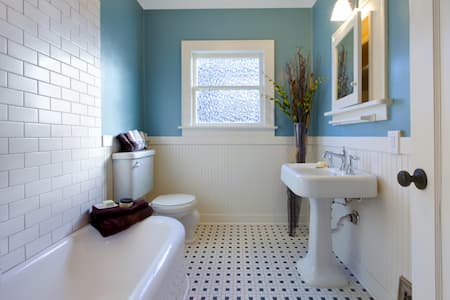Tub Talk: Replacing vs Resurfacing

When it comes to updating your bathroom, one of the most significant decisions you'll face is whether to replace your bathtub or refinish it. Both options have their own set of advantages and considerations, and understanding these can help you make an informed choice that best suits your needs and budget.
Tub Replacement
Tub replacement involves completely removing the old bathtub and installing a new one. This process can significantly alter the look and feel of your bathroom, but it also comes with higher costs and more extensive work.
Advantages of Tub Replacement:
- Customization: You can choose a new tub that perfectly matches your style and bathroom décor.
- Modern Features: New tubs often come with modern features, such as better ergonomics, built-in storage, or whirlpool jets.
- Durability: A new tub will likely last longer and have fewer maintenance issues initially.
Disadvantages of Tub Replacement:
- Cost: Replacing a tub can be expensive, considering the cost of the new tub, demolition, disposal of the old tub, and installation.
- Time-Consuming: The process can take several days to weeks, especially if plumbing or structural changes are needed.
- Disruption: The bathroom will be unusable during the replacement process, which can be inconvenient.
Tub Refinishing
Tub refinishing (also known as reglazing or resurfacing tubs) involves applying a new coating to the existing bathtub to restore its original appearance. This process is much quicker and more affordable than replacement.
Advantages of Tub Refinishing:
- Cost-Effective: Refinishing a tub is significantly cheaper than replacing it.
- Quick Process: The entire refinishing process usually takes a day or two, including drying time, when completed by a professional painter with tub resurfacing experience.
- Minimal Disruption: Your bathroom remains mostly functional during the refinishing process.
- Eco-Friendly: Refinishing reduces waste by avoiding the disposal of the old tub.
Disadvantages of Tub Refinishing:
- Longevity: The refinished surface may not last as long as a new tub, typically requiring touch-ups every few years.
- Limited Customization: Refinishing is limited to the existing tub's shape and size.
- Chemical Smell: The process involves strong chemicals that can produce an odor during application.
Comparison at a Glance
Cost:
- Replacement: High
- Refinishing: Low
Time:
- Replacement: Several days to weeks
- Refinishing: 1-2 days by professional painters
Disruption:
- Replacement: High
- Refinishing: Low
Customization:
- Replacement: High
- Refinishing: Limited
Longevity:
- Replacement: 20+ years
- Refinishing: 3-10 years (depending on maintenance)
Making the Right Choice
When deciding between replacing and refinishing your bathtub, consider the following factors:
- Budget: If you are working with a limited budget, refinishing is the more economical choice.
- Time: Refinishing is faster and less disruptive if you need a quick fix.
- Customization Needs: If you desire a complete change in style or features, replacement is the way to go.
- Long-Term Plans: For a long-lasting solution with minimal maintenance, replacement may be worth the investment.
In conclusion, both tub replacement and refinishing have their pros and cons. Refinishing is ideal for those seeking a cost-effective, quick solution, while tub replacement is suited for those looking for a more permanent upgrade with the flexibility of customization. Assess your specific needs and preferences to make the best decision for your bathroom renovation project. If you're still unsure, consulting with professional painters like Johnson Painting LLC can provide some valuable tub talk on replacing vs. refinishing and additional insights to help you achieve the perfect outcome for your space.
We Get the Job Done Right! Contact Our Mobile Painters Today!